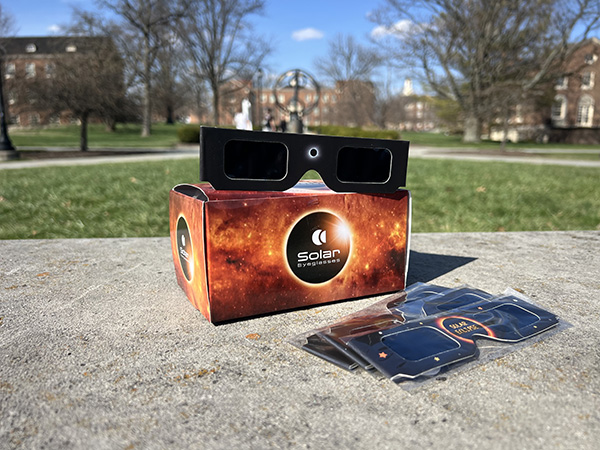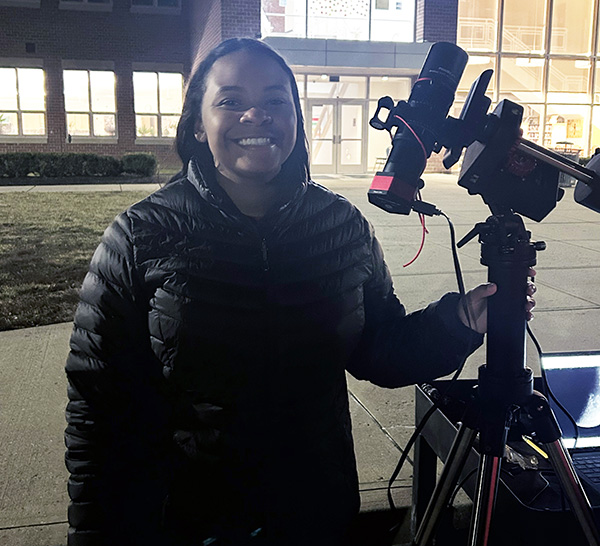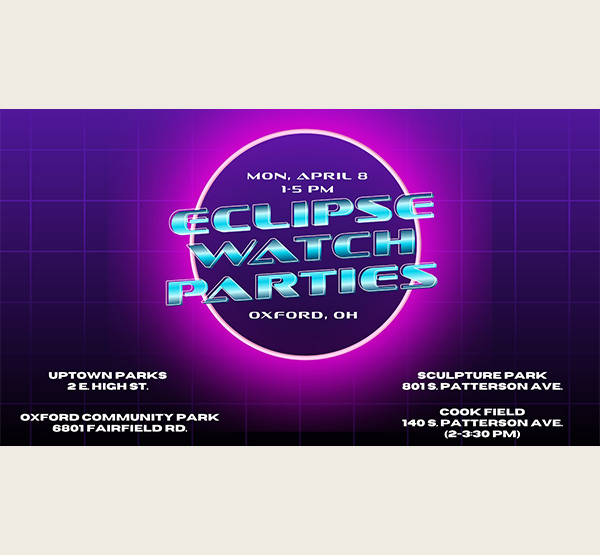Two Miami Engineering students team with Talawanda students on eclipse project
Miami has purchased 30,000 glasses to safely watch the April 8 total solar eclipse
Two Miami Engineering students team with Talawanda students on eclipse project

The April 8 total solar eclipse will be here before you know it.
There is still plenty of time to determine where to enjoy the astronomical event, which the Ohio Department of Natural Resources says won’t be seen in Ohio again until 2099.
Chemical Engineering major Olivia Freeman has been preparing for the eclipse for weeks as part of a group from Miami University working with Talawanda High School.
The first-year student from Brownsburg, Indiana, said she is “unbelievably excited” about the experience she knows will stay with her for years to come.
“I’ve never seen a total solar eclipse before," she said. "To be able to view it with the professional equipment we have will be a once-in-a-lifetime experience.”
The team — one of 20 from across the country — will set up at Talawanda High School, taking pictures and tracking the eclipse “as we wait for it to reach totality,” Freeman said.
The eclipse process will start at approximately 1:53 p.m., with totality beginning at 3:08 p.m. in the Oxford area. That’s when experts say the sun will disappear behind the moon for 2 minutes and 51 seconds.
Miami has purchased 30,000 protective glasses for students, faculty, and staff who would like them to view the eclipse safely. They will be available at the Armstrong Student Center the week of April 1 and at the Seal at the Hub near Upham Hall from noon to 2 p.m. the day of the eclipse, said Scott Walter, assistant vice president for Student Life.
Also on the day of the eclipse, they will be available at the 2 p.m.-3:30 p.m. MAP watch party at Cook Field and other watch parties throughout Oxford beginning at 1 p.m., with extra glasses being made available to the city.
"They will be delivered to the residence halls as well for students that live on campus," said Kailey Costabile, assistant director for student activities in Miami's Center for Student Engagement, Activities, and Leadership.

A spotlight on STEM fields
Freeman became involved in the eclipse project through the National Society of Black Engineers. Keisha Norris, assistant director of academic advising and student initiatives in Miami’s College of Engineering and Computing (CEC) who serves as the group’s advisor, mentioned the project at a meeting last semester.
Freeman volunteered, along with Quinn Donnelly, a sophomore majoring in Physics and Mechanical Engineering. They worked with Joanna Hohn, Miami’s assistant director of outreach for CEC, who has supported them through the project.
“I am so happy that these two young, female engineering students are working on such a cool project and with local high school students,” Norris said. “They are amazing, and I think this is so inspiring for more young women to see and hopefully get involved in science.”
The grant Talawanda High School science teacher Heidi Schran received for the project helped buy the telescope and has put a positive spotlight on STEM (science, technology, engineering, and math) that will continue long after the solar eclipse is over.
Funded by the National Science Foundation, this work ultimately will allow scientific analysis of the sun’s inner corona.
Organizers said the project also includes an array of lifelong learning activities, including an opportunity for girl-serving organizations to participate in the Dynamic Eclipse Broadcast (DEB) Initiative, the nationwide citizen science project equipping participants with the technology and resources to capture and broadcast solar images during the total solar eclipse.
The grant was awarded to Cosmic Pictures and shared with DEBI and the National Girls Collaborative.
Group leaders participating in DEB through the Einstein’s Incredible Universe Project will receive ongoing professional development training on space science and project-specific data collection.
Freeman said she would like to see more women and women of color in STEM fields to provide more diverse perspectives.
“I think the eclipse will be an example as to what people with an interest in STEM can do,” she said. “Not only is it a fun project, but it is also a project that will provide a lot of useful data and information to organizations like NASA.”

‘Total Eclipse of the Parks’ and other events
The Institute for Learning (ILR) at Miami, in partnership with the Richard and Carole Cocks Art Museum, will host “The Imminent Solar Eclipse” from 4-5:15 p.m. on April 4. Jerry Riesenberg, an instructor for ILR, and Stephen Alexander, professor of Physics, will give a lecture on the solar eclipse, including how to best experience the special event. Register for the in-person or online event.
Because Oxford falls into the path of totality for the solar eclipse, several solar-themed events are planned for the community, including “Total Eclipse of the Parks” the first weekend in April ahead of the eclipse with a movie marathon, “Space Race,” festival and more.
Eclipse watch parties will be held in several Oxford community parks and at the art museum's Sculpture Park.
Jessica Greene, assistant city manager, said officials are planning for potentially large crowds in Oxford.
“It is hard to estimate the number of people who will come to town, and it will be heavily weather-dependent,” she said.
The city is working with Butler County Emergency Management Services to prepare for public safety, Greene said, and "we will continue to work with residents and business owners on how to prepare for a possible large influx of people into our community.”
The eclipse-related events are sponsored by the Oxford Community Arts Center, Miami University, Enjoy Oxford Visitors Bureau, the Oxford Chamber of Commerce, Oxford Lane Public Library, and the city of Oxford.